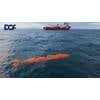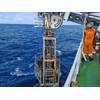NL Government Helps Power Regional Maritime, Offshore Energy, Subsea Tech Cluster
Minister Andrew Parsons, Industry, Energy & Technology, Newfoundland & Labrador, Canada, discusses the innovative technology cluster that has grown within and outside of his province, with insights on the technology and the market sectors that will power the region’s and the country’s future.
- Watch the full interview with Minister Andrew Parsons, Industry, Energy & Technology, Newfoundland & Labrador, Canada, on Marine Technology TV:
Andrew Parsons is a member of the House of Assembly for a district called Burgeo-La Poile, but he’s also the Minister of Industry, Energy and Technology in the Government of Premier Dr. Andrew Furey.
“When the Premier took over government in August of 2020, he combined the previous departments of natural resources with the economic development responsibilities of other departments, combining it all into one shop, but really also putting a focus on technology, putting that in the departmental name,” said Parsons in a recent interview with Marine Technology TV.
Today his department handles all technology, everything from mining, electricity, oil and gas, offshore, renewables, marine technology, aiming to build a base for economic development opportunities and investment attraction.
“It's a wide, encompassing department, but I'm surrounded by an amazing team of public servants, people that really love Newfoundland and Labrador, people that go above and beyond to make people interested in our province and give them a reason to come here and to invest,” said Parson.
With a population just north of half a million, Newfoundland & Labrador is a small province, but its natural resources and cumulative centuries experience living and working by and on the ocean has created a unique and dynamic cluster of excellence in maritime, subsea and offshore energy.
“When you look back historically, the fishery was the backbone,” said Parsons. “But that has grown over time, and now we are building on this blue economy, and the expertise has shifted.”
Specifically, the discovery of oil and gas fields offshore helped to not only bolster the finances of the province, but the cumulative experience of discovering and recovering oil and gas in close proximity to iceberg alley has helped this small population create, refine and export a long list of technologies aimed at working efficiently, effectively and safely in some of the ocean’s harshest conditions.
“We are home to the Hibernia gravity-based structure, which is the world's first offshore oil structure specifically designed to deal with harsh environments, including icebergs,” said Parsons. “We are known as the east coast energy capital, and we cannot overstate the importance of oil to our province. In addition, we export our [offshore oil and gas] expertise all over the world.” As it moves now into aquaculture and marine biotechnology, Parsons observes: “It's amazing, for our province as small as we are, we're certainly batting above our weight when it comes to the ideas that are created here, set up here and then brought elsewhere.”
Banking on Success
The cumulative ocean industry is the driver of the Newfoundland & Labrador Province. The fishery is a billion-dollar industry, but like any commodity, it fluctuates.
“Last year the numbers were a bit lower, we just had a shade over 16,000 people employed [across the industry],” said Parson. “As I mentioned [we’re moving too into] aquaculture with salmon, trout and shellfish. [Last year] production was about 19,000 tons, which was almost a 50% increase over the previous year. So you're looking at about a $200m market value that is anticipated to grow.”
While the fisheries are the backbone, offshore energy is the muscle.
Again, a commodity which has its peaks and valleys. In 2023 the Province produced about 73 million barrels, or about $8 billion in oil production. With the Terra Nova FPSO going back into production in November 2023, Parsons expects oil production to rise to around 82 million barrels this year.
Another promising development is Cenovus’ nearly billion-dollar investment in constructing the West White Rose Project now, another key plank in ensuring rising production numbers.
“When you're talking about 16% of our GDP and when you're talking about a shade over 10% of our actual government revenue, it's a big, big deal,” said Parsons. “In all, we have four developed oil fields: Hibernia, Terra Nova, White Rose and Hebron. Everybody's producing again this year, [and the output is] going to go back up,” helping Newfoundland & Labrador retain its spot as the number three oil and gas producer in the country behind Alberta and Saskatchewan.
“Overall, our economy this year is expected to grow, the GDP growth is expected to be about 5% this year, which is certainly music to the ears of our finance minister, Siobhan Coady,” said Parsons.
 The Launch is a state-of-the-art living lab operated by the Marine Institute in Holyrood. Photo courtesy the office of Minister Andrew Parsons
The Launch is a state-of-the-art living lab operated by the Marine Institute in Holyrood. Photo courtesy the office of Minister Andrew Parsons
The "Crown Jewels" of the Province
The Newfoundland & Labrador cluster is unique in the way that government, industry and academia mutually support one another. In assessing the ‘spaces and places’ that he finds instrumental in the Province’s success, Parsons was eager to share his view, with a caveat: “when you’re asked to pick favorites, that’s a tough question for any politician, but sometimes you've got to bite the bullet!” Here’s the assets he selected:
- The Launch: “A state-of-the-art living lab operated by the Marine Institute out in Holyrood, which is my wife's hometown! It's an amazing facility, amazing community, and it brings the world's harshest cold ocean environment to the client. They're dealing with ocean tech through R&D, testing, demonstration; taking everything together and putting it to the test. You're looking at near Arctic conditions, and it's a test center for the NATO defense innovation accelerator.”
- The Co. Innovation Centre: The Co. Innovation Centre is helping to address the tech needs of established companies as well as the new ones that are pursuing remote ops in energy, healthcare, mining, fisheries, transportation and more.
- The National Research Council: “NRC has an amazing facility in St. Johns that is one of the most advanced indoor model ocean facilities in the world.” Among the facilities are the ability to produce multi-directional waves in extreme temperatures, at extreme sea states, able to generate wind to simulate real world marine conditions. NRC has a towing tank able to test most any vessel, including high speed vessels such as warships, to bulk carriers and patrol vessels. NRC also has “an amazing ice tank to simulate what's going on in the Arctic,” able to grow ice quickly and control its properties.
- Center for Marine Simulation: An arm of the Marine Institute, which is a gem in itself with an amazing group of marine tech training, research and development.
The People
The environment is unique, sometimes harsh, always beautiful. The facilities are world-class, born in the fisheries, refined and globally expanded on the back of offshore oil and gas exploration. But the magic of Newfoundland & Labrador is the people: arguably the nicest collection of 500,000+ people on the planet, but also the most innovative and technically adept.
“We are lucky to be surrounded by generations of brilliant Newfoundlanders and Labradorians with expertise,” said Parsons. “We try our best to help promote them and share them.”
While he stressed the list of leaders in the province is exhaustive, he did share insights on a few leaders and their contribution:
- Captain Chris Hearn at the marine simulation center. He is an amazing master mariner for Canada and for the world, also sitting on the board of the Irish Maritime Energy Cluster. We have a history of providing expertise that we love to share with our neighbors around the world and Chris is a prime example of that.
- Dr. Paul Brett, Vice President of the Marine Institute and the chair of Oceans Advance. The Marine Institute hosted an ROV competition for high school kids, and going down and spending time with Paul at that, you can see why Marine Institute boasts the student population that to do because you just like being around Paul. He's a great guy, doing a great job of promoting the school and what they teach to these kids. Paul's an educator, he's an administrator, he's a data specialist. He's got too many things on his resume to name, but he's absolutely a leader in this province, and a great person to boot.
- Dr. Lesley James, the Chevron Chair of Petroleum Engineering, is doing a lot of work with us right now on carbon capture and offshore basins, and at the same time recognizing that we have to reduce the emissions offshore. When you look at emission reduction, we are far ahead of most other oil producing nations, but that doesn't mean we can't do better when we talk about net-zero aspirations. She's played a big part of that.
Find Your Home in Newfoundland & Labrador
While the government is seeking to help develop its own companies, technology and expertise for its own domestic use and for export globally, at the same time it wants to attract international talent and investment, and Parson is quick to point out that with its Eastern locale, it is closer to Germany than British Columbia, the west coast of Canada. There are ample incentives for organizations to set up shop in the Province and collaborate with local companies and academia, but Parsons brings it back to the population and its mentality.
“One of the advantages of being our government is that we are truly nimble, we are adaptive and we want people to come here,” said Parsons. “We go out of our way to welcome you, and we'll work with you. We try to be as least rigid as possible. And again, surrounded by an amazing team of people that are interested and committed to economic development and opportunity. We want you to set up shop in Newfoundland and Labrador; it's very easy to sit down with decision makers in our province to get things done.”
“Our province has been shaped by the Atlantic Ocean. It can be extremely cold, extremely unforgiving. If it works here, it will work anywhere. The technology we [develop and] use here can be adapted to anywhere else in the world. We are adaptive, we're nimble, we're problem solvers. And at the end of the day, we are collaborative. We want to work together, to offer people a chance to make things better wherever they're in this world. This is just a little corner of the world that I think can help supply some of the strategies and solutions that will help us on a global basis.”


![“Our province has been shaped by the Atlantic Ocean. It can be extremely cold, extremely unforgiving. If it works here, it will work anywhere. The technology we [develop and] use here can be adapted to anywhere else in the world. We are adaptive, we're nimble, we're problem solvers. And at the end of the day, we are collaborative."
Minister Andrew Parsons, Industry, Energy & Technology, Newfoundland & Labrador, Canada. Photo courtesy the office of Minister Andrew Parsons](https://images.marinetechnologynews.com/images/maritime/w80h50c/province-shaped-153427.jpg)



![“Our province has been shaped by the Atlantic Ocean. It can be extremely cold, extremely unforgiving. If it works here, it will work anywhere. The technology we [develop and] use here can be adapted to anywhere else in the world. We are adaptive, we're nimble, we're problem solvers. And at the end of the day, we are collaborative."
Minister Andrew Parsons, Industry, Energy & Technology, Newfoundland & Labrador, Canada. Photo courtesy the office of Minister Andrew Parsons](https://images.marinetechnologynews.com/images/maritime/w800h500/province-shaped-153427.jpg)












 December 2025
December 2025



